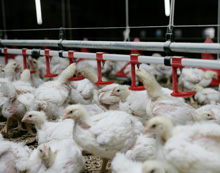‘Poultry will be winning protein in next decade’

The prospects are bright for the global poultry industry, says a new Rabobank report, despite the current turbulent environment and the challenge of meeting a 30% rise in global demand in the next decade.
Turbulent environment
The industry is operating in a very turbulent environment of
• high and volatile feed prices
• uncertain economic recovery
• political unrest in the Middle East, one of the major import regions for poultry products.
• Restrictions and frequently changing import regulations in key markets such as Russia, China and Mexico
• Impact of the earthquake in Japan, a major poultry importing market
• Outbreaks of avian influenza (AI) in Asia
Two-way street between Americas and Asia
“Poultry is going to be the winning protein in the next decade as the world population expands and incomes rise,” says Nan-Dirk Mulder, lead author of the Rabobank report.”But it will be a big challenge for the industry to keep up with the 30 percent demand growth in the next 10 years, growth which is not distributed evenly around the globe.”
Growing demand in Asia is a key driver for the expected growth in the global poultry industry since the feed crops which fuel the industry are most abundant in North and South America, future global investments will increasingly be a two-way street between American and Asian companies. The success of the Brazilian model together with the need for US companies to find new markets will drive further internationalisation of the industry as Asian players will seek to secure future supply for their home markets.
Regional perspectives
While Brazil will remain the dominant player in the export meat market, countries like Ukraine and Argentina have great long-term growth potential. Thailand and China will remain dominant suppliers of labour-intensive poultry products while the US and the EU will be more “access” supply exporters. The EU poultry industry will adapt an increasingly regional focus to better exploit the opportunities of its 500-million consumer base. China, India and South East Asia will be relatively “hot” for foreign investors and may also offer trade synergies with existing business.
Allied industries such as animal genetics, animal nutrition, farm equipment and processing-equipment are also set to benefit from these industry changes as the value chain seeks to modernise and achieve the best use of scarce resources.
Sustainability
Sustainability is going to be a much more important topic in the new market environment, says Nan-Dirk Mulder. “NGOs and clients will be more concerned about the sustainability of poultry production At the same time, animal welfare will become more important. Suppliers in developed markets will need to be pro-active in the debate while retailers and Quick Service Restaurants offer opportunities to set up production chains with higher animal welfare standards to supply the premium market segment.”













